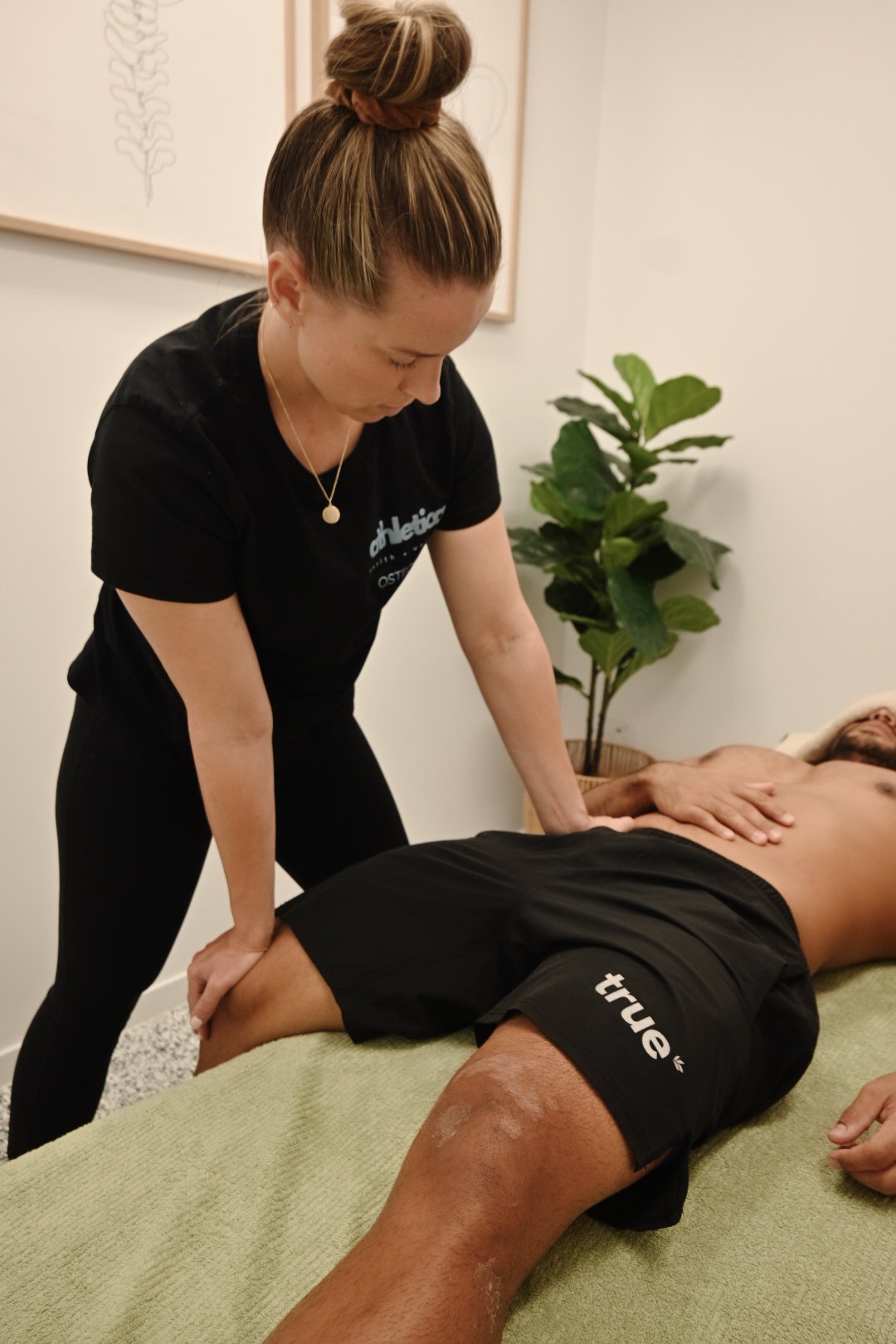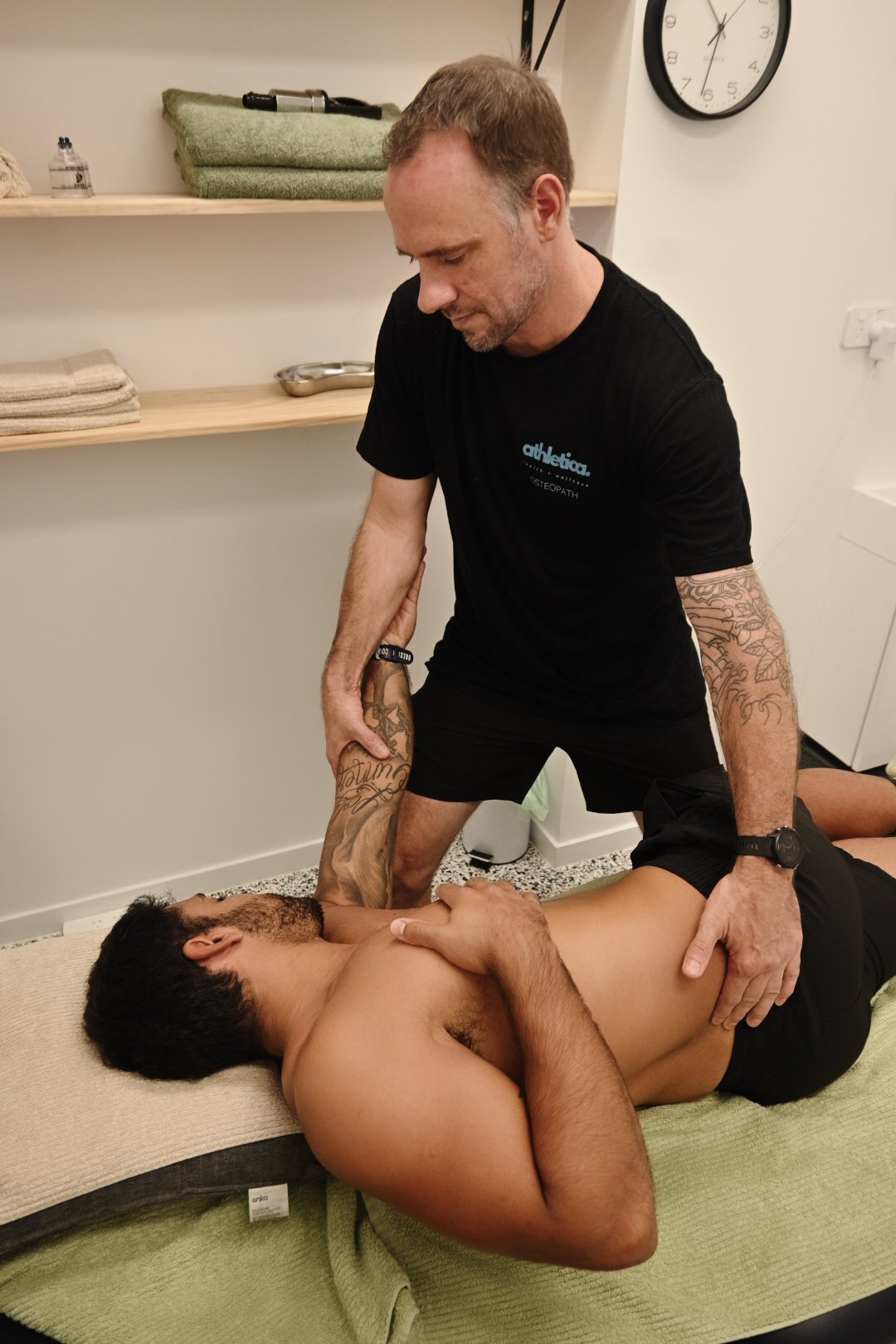
OUR STYLE OF OSTEOPATHY
Direct osteopaths specialise in a treatment style that involves hands-on techniques to assess and address musculoskeletal conditions. Our approach focuses on identifying and treating the root causes of pain and dysfunction, rather than just alleviating symptoms.
Direct osteopaths often use a variety of manual therapy techniques, such as soft tissue manipulation, joint mobilisation, and joint adjustments, to restore balance and improve overall function. They also emphasise patient education and empowerment, helping individuals understand their condition and providing them with tools and exercises to support their healing process. With an attentive and personalised approach, direct osteopaths aim to provide effective relief and promote long-term health and well-being.
OSTEOPATHY AT ATHLETICA
WHAT IS OSTEOPATHY?
Osteopathy is a gentle form of manual therapy for musculo-skeletal conditions. It looks at the body as a unit. Your osteopath will aim at identifying the tissue that causes symptoms and when appropriate, the reason why these symptoms have started to then treat the root cause and prevent re-occurrence. The aim is to find full resolution of your problem, wherever possible.
To adjust the body mechanics, osteopathic treatment mainly consists of articulation (moving joints to re-establish normal range of movement) and soft tissue (massage / trigger points to relax tensed muscles). Manipulations, also known as "high velocity low-amplitude thrusts" or "clicking technique" are sometimes used as well to adjust the body.

VISCERAL OSTEOPATHY
Visceral manipulation is a hands-on therapy that focuses on your organs through addressing their surrounding connective tissues (fascia).
Importance of Visceral manipulation:
For the visceral system to maintain health and homeostasis, each organ must receive unobstructed blood flow, balanced nervous system input, and unrestricted energy flow. Obstructed blood flow leads to an accumulation of cellular waste products in connective tissues causing pain, tension, and edema; Hence further enforcing the benefit of lymphatic drainage through visceral massage and manipulation.
Visceral manipulation can treat:
- Irritable bowel syndrome (IBS), a gastrointestinal condition:
By focusing on visceral techniques, Osteopathy can restore autonomic homeostasis and increase lymphatic flow. Visceral manipulation treats the following IBS symptoms:
- constipation
- diarrhoea
- abdominal distension & pain
- rectal hypersensitivity
Benefits of Visceral manipulations:
- Improved digestion: Through reducing limitations of soft tissues, the normal peristaltic movement in the digestive tract is improved. This encourages healthy digestion.
- Improved organ function: As restrictions within the surrounding connective tissues are released, improved blood flow promotes the restoration & improvement of organ mobility and function.
- Injury prevention: Healthy body alignment promotes efficient & safe movement, hence preventing injuries.
OSTEOPATHS MAY BE ABLE TO HELP WITH:
Lower and upper back pain
Neck pain and stiffness
Sciatica
TMJ Disorders (Jaw Pain)
Shoulder, elbow and wrist injuries and pain
Hip, knee, foot and ankle injuries and pain
Sport and work related injuries
Postural Problems
Muscular aches and pains
Repetitive strain injuries
Whiplash Injuries
Tendonitis
Musculoskeletal pain associated with pregnancy and post-natal care
Gastrointestinal complaints
WHAT TO EXPECT FROM MY FIRST APPOINTMENT
Before your first appointment you will need to complete an online health questionnaire. This includes detailed questioning of your presenting problem, questions about your general health and any other relevant aspects of your health.
This is followed by an examination. Please bring a pair of shorts/leggings/sports wear you are comfortable with, to allow for easy assessment and movement for treatment. From there, your osteopath will explain to you the diagnosis and treatment proposed.
WHAT TO EXPECT AFTER TREATMENT
Most patients will experience improvements after their first osteopathic session. However, the timeline for benefits can vary; some may notice changes immediately, while others might feel the effects only after a couple of days. It’s also not uncommon for patients to encounter a reaction to treatment, sometimes referred to as a "healing crisis", which can manifest as temporary discomfort for a day or two. This response occurs as the body's mechanics adjust following treatment, similar to how muscles might feel sore after an intense workout if they haven't been used for some time.
Osteopathic treatment is typically a gradual journey, and patients will often find that the intervals between experiencing symptoms lengthen over time, potentially leading to a complete resolution of symptoms. As this progress is made, treatment sessions may be scheduled further apart to reflect the advancements in your health and well-being.
HOW IS THE TREATMENT PLAN ESTABLISHED?
At the end of the initial consultation, your osteopath will explain to you as accurately as possible the mechanical cause of your symptom, why your symptoms have started, the direction that needs to be taken, how to get there and how long it is likely to take.
Your osteopath will be interested in your posture at work, your diet, your exercise regime and your hobbies, to give you the best possible advice and work out with you the best treatment plan, that will most easily be integrated to your routine. The treatment plan is discussed between patient and osteopath to find the best solution for you, and patients are encouraged to make suggestions and can ask for alternatives at any time.
Your osteopath will also happily work alongside other health care professionals and may refer you to your GP or another specialist.
HOW MANY APPOINTMENTS DO I NEED TO MAKE?
There are many factors that influence the speed of recovery, depending on what tissue has been injured, how badly it has been injured and of course your age, diet, exercise regime and how long the issue has been going on for.
Your aims will also influence how many treatments you need. Are you simply looking for pain relief, or are you interested in dealing with a chronic condition for good?
Sometimes a patients may only need 1 or 2 treatments. Following that, their body can take over and do the rest of the work. However, generally most patients will need 4 to 6 treatments to re-establish normal mobility in their body (although symptom reduction happens more quickly) and some complex cases may need more sessions. This is discussed from the start, and your osteopath will make a quick assessment of the progress made at each appointment to keep you in control.
Your osteopath will also give you as many self-help tools as possible, such as exercises, diet changes- to speed up recovery.
Services can be attended using a number of compensatory schemes including Medicare, TAC, WorkSafe and private health insurance. Some conditions apply, please speak to us if you wish to use any of these.

